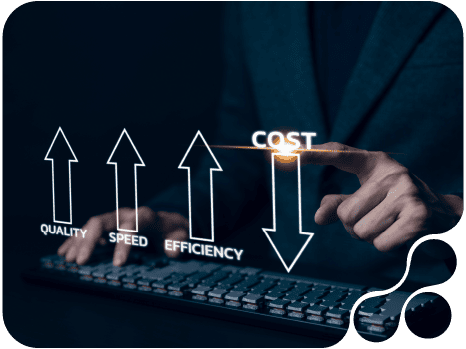
The client struggled with extreme challenges during IoT systems testing due to multiple disparate systems, including issues with interoperability, performance, security, and privacy.
AI/ML models
Connected E2E test optimization suite
Predictive analytics
Cybersecurity tools

Today, sensor technology is more affordable than it was a decade ago, and with accelerated 5G rollouts – IoT systems are becoming more integral to modern lives worldwide. With the growing prevalence of embedded systems on the industrial front and the demand surge among consumers for more intuitive, intelligent features – IoT systems manufacturers are seeking novel methodologies to ensure their systems have high performance, security, and function as intended – without affecting their bottom line. However, they face significant hurdles – from device diversity leading to data explosion, lack of standardization, gaps in usability testing, and the absence of a real-time feedback loop hindering continuous improvement. Moreover, the interconnectedness also becomes a vulnerable spot for advanced cyber threats. Therefore, having a testing environment supported by a uniform API framework, network management, and edge computing that is compliant with global regulatory standards becomes paramount for rolling out secure IoT products and systems.
In a parallel case, our client, a leading IoT device manufacturer, housed multiple interconnected systems comprising hardware, software, sensors, and gateways. The dynamic operational environment of IoT systems not only contributed to multiple use cases and security challenges but led to growing concerns over data and privacy protection as well. Besides the complex manufacturing layers, the company also grappled with higher defect rates in user acceptance due to interoperability issues, multiple private breaches due to unauthorized access, and subpar performance stemming from slower from app to operation cycles and inconsistent behavior across OS versions. The absence of proper visibility and smooth interoperability led to fragmented processes, inefficiency, and higher losses in both revenue and reputation.
To address these challenges, the client required a comprehensive, automated framework-led approach to streamline testing, improve security, and optimize performance across the entire device ecosystem.

Bosch SDS analyzed the client’s current IoT V&V processes and identified the operational inefficiencies, security vulnerabilities, and performance bottlenecks. Our SDS experts developed a framework-driven solution that defined client requirements from end to end, leveraging technologies such as AI and ML, intelligent testing techniques such as cognitive quality assurance (QA), and use case simulation. With this systematic approach, our client streamlined their operations more effectively, ensuring all their devices got tested for every possible use scenario, and drove the following actionable measures:
Our end-to-end V&V framework resulted in the client elevating their testing and QA to deliver top-level IoT devices. Our next-gen solution empowered the client with immense benefits, securing them a safe spot in the market.
30% faster time-to-market
Zero authentication breaches
20% improvement in response time
Enhanced scalability and reliability
Improved compliance
Reduced manual efforts and errors
Seamless integration across devices
Faster defect detection and resolution
Reduced costly fixes post-launch

Bosch SDS brought a unique combination of deep expertise, cutting-edge technology, and a customer-centric approach that helped the client overcome their IoT challenges efficiently. As a trusted partner, Bosch’s Verification and Validation (V&V) capabilities enabled the company to capture market share early and realize revenue faster due to quicker product launches. This also directly translates to positive financial impact, including reduced expenses ranging from operations to product development and post-launch requests. Besides a stronger security posture, the client also elevated their product quality, reliability, and safety. Finally, they also garnered higher customer satisfaction and positioned themselves for continued success in the rapidly evolving IoT landscape.
